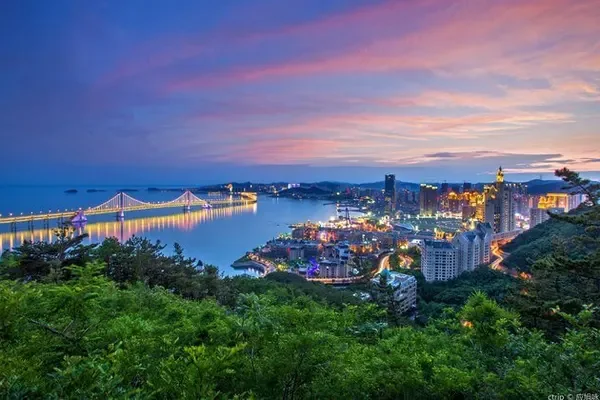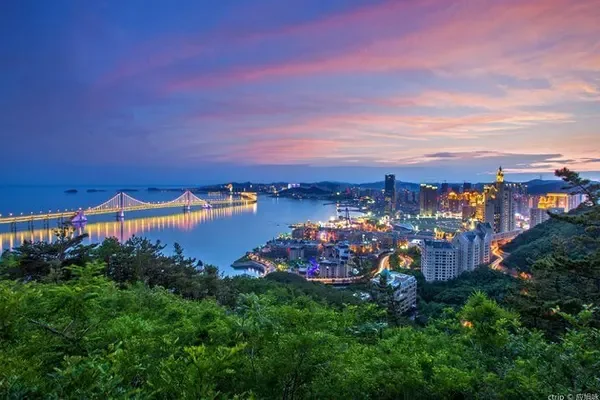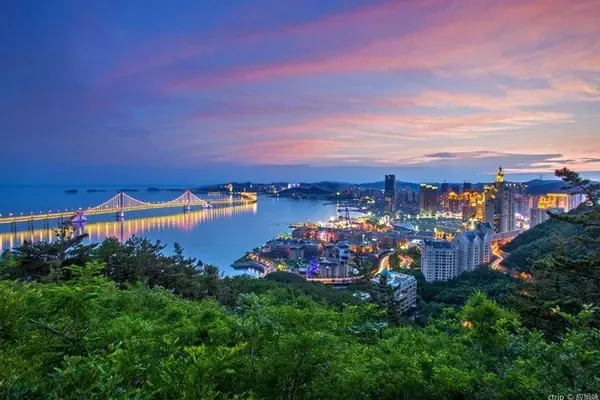Our motherland is vast and abundant, with magnificent mountains and rivers. If you want to ask where is the most beautiful place in early autumn, the photographer will tell you: the most beautiful place on the dam! On this dam is the Ulan Butong Prairie in Inner Mongolia. Every year at the end of September, thousands of photography enthusiasts gather here just to find the most beautiful light and shadow in autumn. Taking advantage of the long Mid-Autumn Festival holiday, a group of 10 of us participated in the [Golden Autumn Drunk Beauty on the Bashang] Bashang Grassland Autumn Scenery and Jinshanling Great Wall Deep Crossing Photography 6-day activity organized by the Yangtze River Delta Photographer Circle. The first two days on the way encountered rainy days. Although there were some regrets, the charming scenery along the way still left a deep impression on us. Day 1: Shanghai - Beijing - Jinshanling Great Wall
At 07:48 on September 19, 2021, take the G110 high-speed rail from Shanghai Hongqiao Station to Beijing South Railway Station, and arrive at Beijing South Railway Station at 13:32 pm, starting a 6-day photography tour on Bashang.
Get out of Beijing South Railway Station, follow the leader of this activity, Mr. Cai Jiesheng, and walk to the designated boarding point. Board the "Jin AX0299" tourist bus. In the next 5 days, the 30 people in the team will take the "Jin AX0299" tourist bus for the whole journey. Then, take a tourist bus to Jinshanling Great Wall, originally planned to shoot the sunset. At around 18:30, the car arrived at Jinshanling in Luanping County, Hebei Province. Due to time constraints, the shooting of the sunset was canceled, and it was adjusted to the sunrise shooting the next day. The local tour guide (Qiangzi) greeted us at the Jinshanling Great Wall Scenic Spot. He has already bought tickets for the scenic spot for us. Everyone must get off the car and verify their identity by swiping their faces so that they can enter the scenic spot to take pictures of the sunrise tomorrow morning.
On the square in the Jinshanling Great Wall Scenic Area, an intangible cultural heritage "Iron Flower" is being staged. Everyone hurried to the car to get a camera to take pictures of this rare and spectacular scene. "Swing iron flower" is to mix charcoal and raw iron in a small iron cage, hang it on the top of a 4-meter-high wooden pole with a rope, and after ignition, 5 people will rotate the wooden pole together, and the charcoal will burn and melt. Under the action of centrifugal force, the molten iron is thrown out tens of meters, and due to the oxidation, it presents a spectacular scene of "iron fire rain" in the air.
Watching the intangible cultural heritage "Iron Flower" under the Jinshanling Great Wall, the photographers shouted: so beautiful, so amazing! After filming, stay in a farmhouse near the scenic spot. Day 2 Jinshanling Great Wall - Ulan Butong Prairie
Get up at 4:30 in the morning, gather in the living room downstairs at 5:00, and take the local villagers to drive to the Jinshanling Great Wall. Due to the rain, half of the people chose not to go because they could not photograph the sunrise in rainy days. I think that since we have come to the foot of the Great Wall, no matter what the weather is like, we should go to the Great Wall to take a look. After all, the Great Wall is the pride of the Chinese people!
The Jinshanling Great Wall is known as the "Great Wall in the National Anthem". It is located between the lofty mountains of the Yanshan Mountains at the junction of Luanping County, Hebei Province and Beijing. This section of the Great Wall is the best-preserved section of the Great Wall with the most exquisite architectural art.
At 5 o'clock in the morning, braved the heavy rain, walked for more than 20 minutes, climbed the Great Wall, saw the style of the Great Wall, and fulfilled the feat of "If you don't reach the Great Wall, you are not a hero"! The most beautiful section of the Great Wall, majestic!
After filming the Jinshanling Great Wall, return to the farmyard to have breakfast, and take the bus at 8:30 to the Ulan Butong Prairie. On the way from Jinshanling to Ulan Butong, I was taken by the guide to the No. 21 Northern Folk House Museum, where I had my first lunch.
The No. 21 Northern Folk House Museum is located in the Mulan Autumn Exhibition Hall in Weichang County, Chengde City, Hebei Province. It is a small scenic spot with a very lively atmosphere. The museum is not big. There are taverns, specialty shops, exhibition halls, restaurants and fruit stands in it. Although the sparrow is small, it has all internal organs. After staying for two hours, I hurried to the dam after lunch. I like this kind of old old house.
Driving from Jinshanling to Ulan Butong, due to the rainy weather, tourist buses are prohibited on the expressway. The whole road is on the ground, and the road is bumpy. It took nearly 9 hours to reach Ulan Butong.
In the evening, the hotel held a welcome banquet for us. The enthusiastic prairie girl offered us a glass of kumiss full of blessings. In a warm atmosphere, the 3-day and 3-night Bashang Grassland Autumn Color In-Depth Photography Collection was launched.
Day 3: Ulan Butong Prairie (Colorful Mountain, Yangshubei, Grassland Pastoral Village Scenery, Huagulu Lake, Huagulu Mountain, Ovootu)
Get up at 4:30 in the morning and set off on time at 5:00. Breakfast can only be settled on the road. Breakfast is dry food the next day. Due to the rugged roads, the means of transportation for these two days was changed to a red jeep, one for six people, and we took car No. 125. On the dam in early autumn, it was quite cold in the morning, especially the two hands holding the camera were aching from the cold.
Wucai Mountain, located in Ulan Butong Township, Keshiketeng Banner, Chifeng, Inner Mongolia Autonomous Region, is one of the main scenic spots for viewing the autumn scenery of secondary forests in the Machang area. In the past few days, the dam has encountered a rainy day that has not been seen in several years. The sky is gloomy in the morning, and it rains from time to time. It is hopeless to shoot the sunrise.
From the second half of September to the first ten days of October every year, due to the effect of slight frost, different tree species on the mountain show different colors due to their different cold resistance. Red, the purple of apricot, the yellow of birch, and poplar, etc., are really "thousands of red are everywhere, and the forests are all dyed."
On the first day of photography in the Ulan Butong Grassland, I took a local off-road vehicle for the whole journey. It was raining, and the tour guide told everyone to get in the vehicle quickly and drive to the next scenic spot, Yangshubei.
Along the way, the scenery outside the window is so beautiful. In order to satisfy everyone's desire to take pictures, the tour guide will selectively stop. A group of sheep grazing in the grass on the side of the road became our shooting target.
The car stopped on the back of the poplar, and the rain stopped, and everyone couldn't wait to walk into a birch forest.
The back of poplars is a scenic spot in Ulan Butong Scenic Area. There are endless mountains and endless grasslands. In fact, there are not many poplars in the area. The main tree species in the forest area are larch, sylvestris sylvestris, birch, spruce, etc. . Wandering in the meadows and among the birch forests, fully enjoying the fresh air bestowed by nature, the beautiful scenery is really eye-catching, and the good ecological environment nourishes the body. It is said that this is an ideal place for photographers.
After shooting the back of the poplar, continue driving to the next scenic spot.
Stop and take pictures of the cattle grazing on the hillside by the side of the road.
The jeep was driving on a rugged mountain road that was not originally a road. It rained continuously and the road was muddy. There was no road at all. The road was made by the wheels of the jeep. The car bumped along two deep ruts and galloped on the prairie . Let you feel what a real off-road is, and your viscera are about to collapse from the bumps!
A jeep in front of us got stuck in the quagmire, the wheels slipped and couldn't get out. All the tourists got out of the car and finally drove out of the quagmire after repeated adjustments.
When we came to the people in the grassland, the herdsmen presented us with snow-white hada, and the enthusiastic grassland girl offered us a glass of kumiss full of blessings.
Then came to the wolf base in the wild, photographed wild wolves, and had the opportunity to have close contact with wild wolves.
Filming Beauty and the Wolf.
After shooting wild wolves, I went back to the grassland to shoot a group of life scenes of grassland people.
There is no deliberate arrangement, everything is casual, and the conversation is lively. When many people are still waiting for the call to start, the performance is actually coming to an end.
Take the jeep to the next scenic spot: Huagulu Lake.
This is Huagulu Lake, just like the small rivers that can be seen everywhere in the south of the Yangtze River, it can be seen that the water on the grassland is very precious.
A horse riding team came by the Huagulu Lake
Herdsmen's self-driving cars are driving on this muddy mountain road, and most people really dare not drive them.
The jeep bumped all the way and came to Huagulutai again.
The front line of Huagulutai was the main battlefield of Kangxi's war against Galdan, and the historical relics are now covered by vast grasslands, leaving cattle and sheep all over the mountains and plains.
We climbed to the highest point and enjoyed the stunning grassland scenery.
When we came to the last stop, Aobaotu, "Aobao" is a Mongolian transliteration, which means "duizi", which means a pile made of wood, stone, and soil. It originated from the Mongolian plateau, but it is not unique to the Mongolian plateau. "Spit" is a nearly round big mountain bag. Aobaotu is located in Yuanbaoshan Village, Sumu, Ulan Butong.
The terrain of Aobaotu Scenic Area is rolling and undulating, the trees are well arranged, and the terrain is relatively high. In the evening, camels pass by here one after another, forming a special landscape.
The terrain of Aobaotu is relatively high. In autumn, you can see a large golden birch forest when you shoot autumn scenery. If you find the right time, good light and shadow effects can create a large film. Finding a special angle is also great!
Watching camel trekking in the desert, taking pictures of the sunset and sunset on the grassland, and spending an unforgettable day on the grassland during the Mid-Autumn Festival.
Day 4: Ulan Butong Prairie (Houshan, Princess Lake, Panlong Canyon, Horses Treading Water, Galloping Horses)
Take the bus at 5 o'clock in the morning and go to the back mountain of Princess Lake, one of the nine sunrise shooting sites in Ulan Butong, to shoot the sunrise and morning fog.
Climbing up a small hill before dawn, the cold wind blows through your clothes and freezes your hands. In the early autumn season, you can taste the power of low temperature.
When the morning light rises, the pasture that has been frozen all night slowly warms up, and the water vapor will slowly rise here, forming a continuous advection fog. These fogs shuttle between the mountains and the woods, and the beauty is unimaginable.
After shooting the sunrise from the back mountain, take the bus to Princess Lake. Princess Lake is located in the Ulan Butong Prairie in Hexigten Banner, Inner Mongolia. At the entrance of the scenic spot, there is a statue of Lanzigerge.
According to legend, Lan Qigege, the third princess of Emperor Kangxi, was forced to marry Galdan and passed through the grasslands of Inner Mongolia, weeping into a lake with grief. Such a small piece of water has become a must-see attraction for people who come to Ulan Butong. This small lake, decorated with white birches, wildflowers, grasslands, deserts, and various shrubs on the shore, is extraordinarily enchanting and has become a favorite scenic spot for people.
The blue sky and white clouds, mountains and colorful forests are reflected in the clear lake water, which makes people refreshed and intoxicated.
From Princess Lake, take a bus to Panlong Canyon, which is a famous canyon on the Ulan Butong Grassland. There is a meandering river flowing at the bottom of the valley all year round, like a dragon lying in the beautiful valley, which is the origin of the name of Panlong Canyon.
Panlong Canyon is a quiet place integrating grassland features, primitive forests, rivers, lakes, ravines and valleys. Without the slightest precipitous and majestic appearance, it shows a primitive beauty and a unique beauty.
At 3:00 in the afternoon, I came to the performance site of Mata Water Flower, which was a full hour earlier than the opening time of 4:00, in order to grab a good seat.
The water flow in this place is not too urgent. The most important thing is the strong background. On the undulating hills, the trees grow in the golden autumn season, a large piece of golden yellow, plus the white water splashed by the horses running, it is really beautiful.
Thousands of horses flew by, and the water splashed in all directions. It was a strange picture of the beauty of galloping, the beauty of power, intertwined. The scene of galloping horses in the splashing water.
At 4:30 p.m., I came to the scene of shooting "Galloping Horses", and saw the three-story photography team on the hillside (the first row was sitting, the second row was on tripods, and the third row was standing). There are hundreds of meters, and the number of people watching exceeds a thousand.
The horses came from far and near with the roar of running and dust, and the golden light glowed under the setting sun. The scene was very shocking.
Among the running horses, there are also ponies that are nursing.
Chased by the shepherds, the herd of horses galloped down the hillside, much like a large group of cavalry rushing towards the enemy's position on the ancient battlefield. The scene is very spectacular.
18:10 The sun sets, and there is a serious traffic jam on the prairie...
Day 5 Ulan Butong Prairie (Beigou, Europe and America Scenic Area, Hatoba, Mugui)
At 5:30 in the morning, I rushed to Beigou to shoot the sunrise. Although there was no advection fog, the sunrise in Beigou was still refreshing and a good place for photography.
Beigou is a long ditch running from north to south. Because it is located in the north of the original field of Hongshan Army Horse Farm in Ulan Butong, the local people call it Beigou.
The other end of the boardwalk is a European-style scenic spot, the hillside is covered with birch trees, and the scenery is beautiful.
The yellowed pastures on the grassland are piled up with haystacks arranged by herdsmen
This is the outdoor shooting base of Bashang Grassland, and many movies and TV series are shot here every year.
In the afternoon, arrange to shoot Hatoba and Mugui. Hamoba is located in the "Huamugou National Forest Park" scenic spot. The lake of Hamoba winds in the hilly canyon. On the grassland, the landform of "two mountains and one ditch" is very unique and provides a wider view. , making this a paradise for photographers.
There are many hills and mountains here, and the landform is unique. The autumn scenery is gorgeous and colorful. The red leaves all over the mountains and the bright yellow birch leaves blend together to form a picture of nature.
In fact, this scenic spot does not have too many characteristics, it is still possible to feel the scenery along the way on foot.
Mugui is the focus of shooting in Hamoba. In the evening, the photography team waiting on the hillside is a very spectacular scene.
On the opposite side of the mountain are patches of birch trees, on the mountainside are patches of irregular lawns, at the foot of the mountain are old elm trees with graceful posture in twos and threes, and in the gaps between the trees are round or rectangular sheep pens and cattle pens surrounded by wooden fences. . As sunset approached, the herdsmen came back from herding sheep, and when hundreds of sheep entered the village trail, they heard the sound of shutters being pressed in unison.
On the sixth day, Bashang—Beijing—Shanghai checked out at 5:00 in the morning, and returned to Beijing from Ulan Butong, Inner Mongolia. It was raining all the way. Due to the rainy days, tourist buses were prohibited on the expressway. The whole road was on the ground. Bumpy, it took nearly 9 hours to reach Beijing South Railway Station.
At 15:49 pm on September 24th, I took the G151 high-speed rail from Beijing South Railway Station to Shanghai Hongqiao Station, and returned to Shanghai safely at 22:12 pm, ending the 6-day wind tour.



